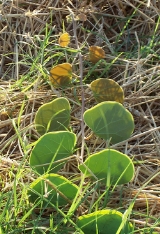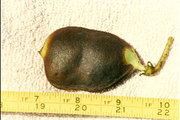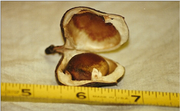
Marama bean
Encyclopedia
Tylosema esculentum, the Morama bean, is a long-lived perennial
legume native to arid
areas of southern Africa
. Stems grow at least 3 metres, in a prostrate or trailing form, with forked tendrils that facilitate climbing
. A raceme
up to 25mm (1 inch) long, containing many yellow-orange flowers, ultimately produces an ovate to circular pod, with large brownish-black seeds
.
A traditional food plant in Africa, this little-known vegetable has potential to improve nutrition, boost food security, foster rural development and support sustainable landcare.
. The plant is dormant over winter in its native home - South Africa
, Namibia
and Botswana
- but might possibly remain evergreen in less harsh environments.
The tuber can grow very large - at least 10kg, perhaps much larger. In Botswana a tuber of 277kg has been found.
The seeds develop in typical legume pods, albeit large and squat in shape - with typically one or two seeds per pod.



. The seeds can also be ground or boiled. The beans keep well, due to their hard outer shell.
The tuber is also edible, but needs to be harvested from young plants (one or two years old) - after this age the tuber becomes astringent
and fibrous.
is necessary in order to ensure satisfactory germination
rates. As for most legumes, a pH
neutral soil is preferred. The plant typically grows in very sandy loam, where waterlogging would not be a problem. Despite much global interest in this plant, propagation rates are still fairly low.
The plant can be grown outside, unsheltered, as far north as Zone 8 in the United States and perhaps further north; above ground growth is killed back by winter freezing, but the plant reemerges each Spring in late May. The greatest impediment to producing a crop of seeds is the long maturation time for the seed pods - which is right up to the first hard freeze of the year. Waterlogging is indeed an issue - leading to root rot - and a well drained sandy loam is preferred, but not essential.
Curiously, this and the other three members of the genus Tylosema
are possibly unique within the family Fabaceae
in the fact they exhibit heterostyly
. This reduces propagation potential, and obviously reduces seed production rates for cropping.
Perennial plant
A perennial plant or simply perennial is a plant that lives for more than two years. The term is often used to differentiate a plant from shorter lived annuals and biennials. The term is sometimes misused by commercial gardeners or horticulturalists to describe only herbaceous perennials...
legume native to arid
Arid
A region is said to be arid when it is characterized by a severe lack of available water, to the extent of hindering or even preventing the growth and development of plant and animal life...
areas of southern Africa
Africa
Africa is the world's second largest and second most populous continent, after Asia. At about 30.2 million km² including adjacent islands, it covers 6% of the Earth's total surface area and 20.4% of the total land area...
. Stems grow at least 3 metres, in a prostrate or trailing form, with forked tendrils that facilitate climbing
Vine
A vine in the narrowest sense is the grapevine , but more generally it can refer to any plant with a growth habit of trailing or scandent, that is to say climbing, stems or runners...
. A raceme
Raceme
A raceme is a type of inflorescence that is unbranched and indeterminate and bears pedicellate flowers — flowers having short floral stalks called pedicels — along the axis. In botany, axis means a shoot, in this case one bearing the flowers. In a raceme, the oldest flowers are borne...
up to 25mm (1 inch) long, containing many yellow-orange flowers, ultimately produces an ovate to circular pod, with large brownish-black seeds
SEEDS
SEEDS is a voluntary organisation registered under the Societies Act of India....
.
A traditional food plant in Africa, this little-known vegetable has potential to improve nutrition, boost food security, foster rural development and support sustainable landcare.
Name
Also known as Marama; Camel's foot; Gemsbuck beans; tamani berry; morama bean; braaiboontjie (Afrikaans)Form
Summer growth is typically prodigious, particularly in plants older than one year - due in part to its large underground tuberTuber
Tubers are various types of modified plant structures that are enlarged to store nutrients. They are used by plants to survive the winter or dry months and provide energy and nutrients for regrowth during the next growing season and they are a means of asexual reproduction...
. The plant is dormant over winter in its native home - South Africa
South Africa
The Republic of South Africa is a country in southern Africa. Located at the southern tip of Africa, it is divided into nine provinces, with of coastline on the Atlantic and Indian oceans...
, Namibia
Namibia
Namibia, officially the Republic of Namibia , is a country in southern Africa whose western border is the Atlantic Ocean. It shares land borders with Angola and Zambia to the north, Botswana to the east and South Africa to the south and east. It gained independence from South Africa on 21 March...
and Botswana
Botswana
Botswana, officially the Republic of Botswana , is a landlocked country located in Southern Africa. The citizens are referred to as "Batswana" . Formerly the British protectorate of Bechuanaland, Botswana adopted its new name after becoming independent within the Commonwealth on 30 September 1966...
- but might possibly remain evergreen in less harsh environments.
The tuber can grow very large - at least 10kg, perhaps much larger. In Botswana a tuber of 277kg has been found.
The seeds develop in typical legume pods, albeit large and squat in shape - with typically one or two seeds per pod.



Uses
The plant is a significant food-source for the people of the Kalahari because of the high protein and oil content of its large seeds (20-30gm each). The seeds are usually roasted, imbuing them with a more palatable flavour - comparable to cashew or chestnutChestnut
Chestnut , some species called chinkapin or chinquapin, is a genus of eight or nine species of deciduous trees and shrubs in the beech family Fagaceae, native to temperate regions of the Northern Hemisphere. The name also refers to the edible nuts they produce.-Species:The chestnut belongs to the...
. The seeds can also be ground or boiled. The beans keep well, due to their hard outer shell.
The tuber is also edible, but needs to be harvested from young plants (one or two years old) - after this age the tuber becomes astringent
Astringent
An astringent substance is a chemical compound that tends to shrink or constrict body tissues, usually locally after topical medicinal application. The word "astringent" derives from Latin adstringere, meaning "to bind fast"...
and fibrous.
Propagation
The seed's hard outer shell means that scarificationScarification
Scarifying involves scratching, etching, burning, or superficially cutting designs, pictures, or words into the skin as a permanent body modification.In the process of body scarification, scars are formed by cutting or branding the skin...
is necessary in order to ensure satisfactory germination
Germination
Germination is the process in which a plant or fungus emerges from a seed or spore, respectively, and begins growth. The most common example of germination is the sprouting of a seedling from a seed of an angiosperm or gymnosperm. However the growth of a sporeling from a spore, for example the...
rates. As for most legumes, a pH
PH
In chemistry, pH is a measure of the acidity or basicity of an aqueous solution. Pure water is said to be neutral, with a pH close to 7.0 at . Solutions with a pH less than 7 are said to be acidic and solutions with a pH greater than 7 are basic or alkaline...
neutral soil is preferred. The plant typically grows in very sandy loam, where waterlogging would not be a problem. Despite much global interest in this plant, propagation rates are still fairly low.
The plant can be grown outside, unsheltered, as far north as Zone 8 in the United States and perhaps further north; above ground growth is killed back by winter freezing, but the plant reemerges each Spring in late May. The greatest impediment to producing a crop of seeds is the long maturation time for the seed pods - which is right up to the first hard freeze of the year. Waterlogging is indeed an issue - leading to root rot - and a well drained sandy loam is preferred, but not essential.
Curiously, this and the other three members of the genus Tylosema
Tylosema
The genus Tylosema is in the plant family Fabaceae.There are four documented species within the genus Tylosema:*Tylosema esculentum , Schreiber - Marama bean*T. fassoglensis*T. argentea Brenan...
are possibly unique within the family Fabaceae
Fabaceae
The Fabaceae or Leguminosae, commonly known as the legume, pea, or bean family, is a large and economically important family of flowering plants. The group is the third largest land plant family, behind only the Orchidaceae and Asteraceae, with 730 genera and over 19,400 species...
in the fact they exhibit heterostyly
Heterostyly
Heterostyly is a unique form of polymorphism and herkogamy in flowers. In a heterostylous species, two or three different morphological types of flowers, termed morphs, exist in the population. On each individual plant, all flowers share the same morph. The flower morphs differ in the lengths of...
. This reduces propagation potential, and obviously reduces seed production rates for cropping.

